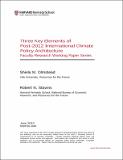Three Key Elements of Post-2012 International Climate Policy Architecture

View/
Metadata
Show full item recordCitation
Olmstead, Sheila M. and Robert N. Stavins. 2010. Three Key Elements of Post-2012 International Climate Policy Architecture. Faculty Research Working Paper Series, RWP10-030, John F. Kennedy School of Government, Harvard University.Abstract
We describe three essential elements of an effective post-2012 international global climate policy architecture: a means to ensure that key industrialized and developing nations are involved in differentiated but meaningful ways; an emphasis on an extended time path of targets; and inclusion of flexible market-based policy instruments to keep costs down and facilitate international equity. This architecture is consistent with fundamental aspects of the science, economics, and politics of global climate change; addresses specific shortcomings of the Kyoto Protocol; and builds upon the foundation of the United Nations Framework Convention on Climate Change.Terms of Use
This article is made available under the terms and conditions applicable to Other Posted Material, as set forth at http://nrs.harvard.edu/urn-3:HUL.InstRepos:dash.current.terms-of-use#LAACitable link to this page
http://nrs.harvard.edu/urn-3:HUL.InstRepos:4448992
Collections
- HKS Faculty Scholarship [761]
Contact administrator regarding this item (to report mistakes or request changes)


